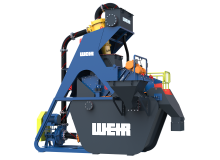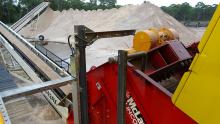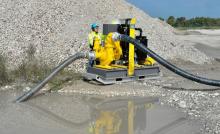
Weir Minerals’ Multiflo, Warman and GEHO dewatering pumps are used across a wide variety of industries and environments.
Simon Jones, the company’s pumps product manager for Europe, says any analysis of the major factors which will influence a dewatering pump purchasing decision must start with the most important questions: What are you pumping and where does it need to go?
“The available net positive suction head (NPSH) is the static pressure you have available in a system to force the water into the pump and will largely determine which model within a style of pump is right for your application,” he explains.
“NPSH can be affected by several variables, such as the static differentiation between a pump’s suction and the water level, the length of the suction pipeline and the pump’s elevation above sea level. Other factors including temperature and specific gravity play a role.”
Jones notes that every pump has a minimum NPSH requirement to ensure continuous flow, which depends on its operating duty point – so the NPSH available needs to be compared to the NPSH required to select a dewatering pump.
“NPSH available must always be more than NPSH required, typically with a 1-1.5m safety margin to prevent suction cavitation.
“Weir Minerals Europe dewatering specialists can work with you to calculate these values and help determine which pump would be best suited for the application.”
Jones says the demands on a pump transporting clear liquid are substantially different to those moving slurry or tailings, from both an energy and wear perspective.
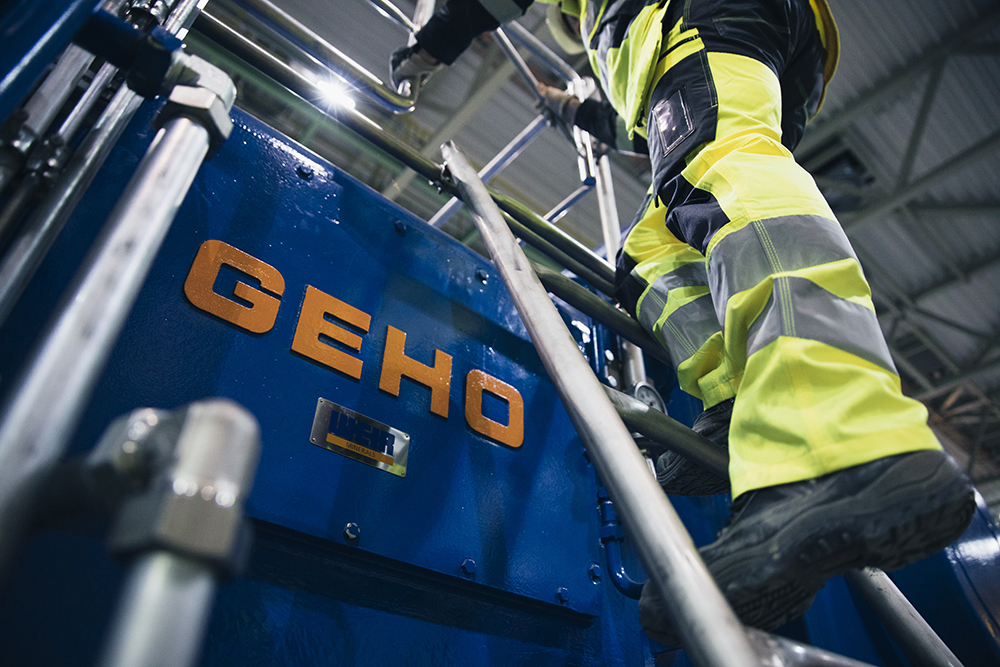
Multiflo models such as the PB and PJ pumps can, says Jones, handle clear, corrosive liquids efficiently. For slurries with high solids content or corrosive properties, Jones explains that GEHO positive displacement pumps provide reliable, highly efficient long-distance transport. He says the GEHO range also lasts longer than most pumps between maintenance and combines high availability with a low total cost of ownership.
Jones continues: “For higher solids applications requiring a high head, Warman DWU horizontal dewatering pumps offer robust wear life, and have a number of sealing options to reduce the dilution of the slurry and lower the required flow of gland water. When dealing with clear water, low-flow gland seals are an efficient, low-maintenance option for sealing. When dealing with mixed slurry, the Warman Hi-Seal expeller’s large diameter offers excellent performance, while mechanical seals can cope with high-pressure environments.
“When selecting a replacement pump for an existing project, it’s vital to obtain up-to-date data on the chemical composition of the liquid to be dewatered. Factors like acidity can change significantly over time as the operation moves into different sections of the ore body, and some seemingly minor pH changes can lead to dramatically reduced wear life and potentially an unplanned shutdown.”
Jones notes that underground dewatering presents a number of potentially expensive challenges not present on the surface, including the need to lift liquids to significant heights, deal with higher-solids content and contend with strict space limitations.
“One of the key decisions facing any underground application is whether to employ a series of pumps to bring liquid up out of the mine (a multi-stage approach), or just lifting via single pump, such as a GEHO positive displacement pump.
“While the upfront cost of acquiring several smaller pumps for a multi-stage approach is usually less than a larger pump which can perform the entire lift, there are a number of factors which can make single lift a more attractive proposition in certain circumstances.
“Among these is the need for additional space to host each stage of the operation. In some underground mines, the cost of excavating extra room will overshadow the cost savings of the smaller pumps.”
Jones states that a single long-distance pump requires less maintenance than a series of units and is often more energy-efficient, which can translate into a lower total cost of ownership.
For many pump operators, manually priming pumps is the most frustrating part of their job, believes Jones. He explains that manually primed pumps require regular, time-consuming adjustment, and the process is prone to failure and can lead to inefficient operation if air isn’t correctly removed from the pump.
“While some static dewatering applications can make do with a manually primed pump, more dynamic applications benefit from an automatic vacuum priming system that prevents the pumps from losing prime.
“Multiflo self-priming CF and RF pump models use a ‘ball float’ priming system, which quickly and efficiently lifts water up into the priming tank and ensures it remains primed at all times. It requires no adjustment and operates without a compressor, removing the inefficiencies and hazards of air prime. “
For situations where a feeding sump would be too expensive or physically impractical, Jones notes that Weir Minerals offers submersible dewatering pumps that cater to a variety of sump and pond sizes, throughputs and conditions.
Due to their portability, quick set-up time and high availability, Jones says submersible pumps are frequently used for a number of temporary applications, either for smaller temporary sumps or as stop-gap solutions until a permanent sump-fed solution can be established.
“For submersible applications with high solids content, the all-chrome wet end of Warman SHW pumps provides long wear life in demanding applications, while the Warman SJG offers efficient dewatering for clear liquids.
“In applications where the pump is at risk of pumping itself out (where the motor must run unsubmerged), a cooling jacket ensures smooth operation by pumping water up into the motor of the pump, preventing it from overheating. This is particularly important where the flow rate can vary without someone to actively adjust the pump rate.
“It’s also important to consider the minimum spacing between dewatering pumps, to prevent them from counteracting one another and operating inefficiently. Weir Minerals engineers can provide guidance on the best way to ensure pumps don’t interfere with each other’s operations.”
For most applications, Jones notes that electric pumps are preferred over diesel, especially in fixed positions, as they’re simpler to operate and cost-effective, as long as the site has reliable power.
Diesel is used mainly in mobile dewatering pumps, Jones explains, such as those operating at the bottom of a mine pit, which require frequent relocation alongside the mine’s sumps as the mine develops.
“In these scenarios, a manually primed centrifugal pump would require a very time-consuming exercise each time it was moved. This makes a self-priming pump highly valuable, as time and personnel are already at a premium.
“For sites with high electricity costs or limited capacity, our engineering specialists can help you find the most power-efficient pumping options that will help drive down total cost of ownership.
“No two dewatering projects are the same. Whether you need a small, submersible pump as a stop-gap solution for a high-solids slurry or a comprehensive pumping solution to handle a high quantity of clear water, Weir Minerals Europe dewatering specialists have the experience to guide you to the right dewatering pump.”
Bart Duijvelaar, product marketing manager Submersible Pumps, and Saksham Dube, product marketing manager Surface Pumps at Atlas Copco, Power & Flow, know that one of the most crucial components of any quarrying application is managing water.
“Whether the water accumulates in the quarry from heavy rainfall, groundwater seepage, or both, it must be removed for the quarry site to continue operations. To keep everyone’s feet and equipment dry, dewatering pumps are used in quarries all around the world.
“The fact that many quarries use pumps that are not intended for the task at hand, resulting in low pumping efficiency and, more crucially, higher costs, may not come as a surprise.”
Duijvelaar and Dube outline some of the factors to consider when selecting a dewatering pump and examine the key challenges that must be addressed.
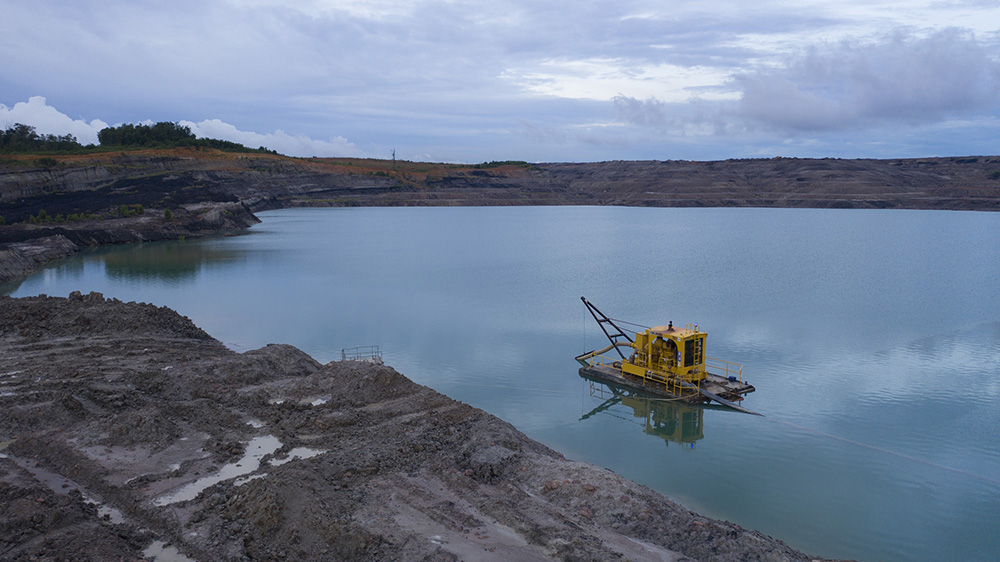
“The first consideration is where the water is being pumped from and where it is going. Apart from overcoming gravity, all pump sizing must consider the amount of friction that needs to be overcome along the entire discharge line length. The so-called head of the pump is the combination of gravity and friction that must be considered for a particular application.
“The sum of gravity and friction, or total head, and the inflow to be dealt with, determine the pump size. We need to apply these concepts to all pump selections, not just in quarries. What can make quarry selection unique is that the distance between the pump and the surface level of the water being pumped might vary over time. A pump that was working efficiently and effectively six months ago might not provide the same performance when the quarry has become considerably deeper due to the greater vertical elevation difference that needs to be overcome.”
When the water comes in and needs to be removed, Duijvelaar and Dube note that operators will tend to use whatever is available, possibly using the wrong pump for the required flow and pump head. In addition, if the water rises more quickly than is being pumped out, they say there could be a tendency to use more pumps. “Usually, there is no time to change to a bigger pump, so they use what is at hand. Of course, when there is a planned extension to the quarry, they are more likely to select the correct pump from the beginning.”
Duijvelaar and Dube say that while there is a wide variety of pumps that can extract water out of a quarry, dewatering pumps are designed specifically for removing dirty water and are built with more wear-resistant parts. “An ordinary pump, for instance, even if chosen according to the correct flow and pump head requirements, would, after time, pump less and less water out of the quarry. By choosing pumps that resist wear better, quarry operators can reduce their environmental impact while increasing uptime.
“Solids suspended in water can cause an impeller to wear and prematurely fail. Atlas Copco’s PAS - PAC range of surface pumps, for instance, which can handle liquids containing solids of up to 100mm in size, has several design features to ensure it performs reliably for more extended periods. The closed impeller in the PAC H pumps is equipped with deflector vanes that keep the mechanical seal clean and free of detritus, making it last three times longer. Additionally, it eliminates the need to flush the pump with water to keep it clean, saving significant energy and money throughout the pump's operational lifetime.”
Duijvelaar and Dube highlight that Atlas Copco’s PAS - PAC self-priming pumps incorporate many design features to provide reliable, high-performance pumping so operators can improve their efficiency and productivity. For example, mechanical shaft seals are set in an oil bath, enabling dry running without damage.
For electric submersible pumps, the pair also note that Atlas Copco has introduced a new patented Wear Deflector Technology platform for the WEDA D70, an innovative hydraulic design that provides a high pump efficacy. The impellers in this pump are made from high-chrome stainless steel and, as such, have high hardness and exceptional wear resistance. The Wear Deflector Technology will find its way into other WEDA submersible pumps as they receive design updates in the coming years.
“Whether there is excavation or blasting operations within the quarry, dewatering pumps need to be moved, which means they have to be transportable. However, when moving pumps around, there is also rough physical handling to consider,” explain Duijvelaar and Dube.
“Transportability is essential, especially for heavier surface pumps. The PAS pump range, for example, is available with a galvanized undercarriage or skid, which is resistant to corrosion and makes the unit easy to move around on site. This range of mobile dewatering pumps recently added the HardHat canopy, a robust polymer, as an alternative. And the models featuring this technology have a road towing trailer for superior transportability.
“For WEDA submersible pumps, the power-to-weight ratio is far superior to conventional pumps. They weigh up to 40 percent less, which makes them easier to handle and move around a site too. They also feature general robust design decisions in combination with specific solutions, such as shock absorbers, so they are more resistant to rough handling.”
Duijvelaar and Dube stress that routine preventative maintenance may also be delayed when other pressing matters present themselves in the daily course of business. They explain that this is one of the biggest differentiators of the dewatering pumps from Atlas Copco, which, they say, have been designed with ease of maintenance in mind.
“Referring back to the PAC H pump, its semi-cartridge seal design allows changeout without dismantling the pump, reducing downtime and simplifying maintenance.
“Thanks to a novel Atlas Copco hinged door design on the pump itself, the PAS – PAC pumps provide superior serviceability on site. All components are exceptionally easy to access for simple servicing and maintenance. The pumps can be cleaned and restarted in a matter of minutes and serviced in under 60 minutes, making them less of a barrier to routine maintenance.
“The latest WEDA drainage pump additions feature a cartridge-type sealing system with a stainless-steel body that enables maintenance to be carried out on-site, ensuring that operators achieve minimal downtime. They also feature easily accessible oil inspection plugs, reducing the time needed for routine inspections and maintenance.”
Duijvelaar and Dube say that in Europe, and especially in certain countries where the rental market for dewatering pumps is around 75%, local aftersales support is essential. They highlight that all pumps in the Atlas Copco range come with full aftersales support and ready availability of spare parts via the company’s global network of customer centres. Product training is also available, particularly useful for rental companies with their own maintenance crew.
“Taking advantage of digitalisation, QR codes are also being implemented, meaning that essential information about parts and spares is just a scan away. Rental firms can also take advantage of the Fleet Link telemetry solution by Atlas Copco, a secured and remote-monitoring feature. Hence, operators are always in control of pumping equipment and operations.”
For electric submersible pumps, the WEDA pumps are said by Duijvelaar and Dube to be the most energy-efficient. The surface dewatering pump ranges are now EU Stage V compliant and are certified to work with biodiesel hydrotreated vegetable oil (HVO), which is fossil-free.
“Consider the technical factors and criteria for the best value and efficiencies when selecting a pump. The pump should be flexible enough to meet the needs of various sites and fulfil the flow requirements while accommodating changes in water level. An oversized pump that can handle a far higher flow capacity may be needlessly expensive and might even shorten the pump’s lifetime. On the other hand, an underspecified pump may struggle to move the media and wear out more quickly, giving it a shorter lifespan.
“With just a few clicks, Atlas Copco has greatly simplified the sizing problem accounting for gravity and friction losses. We have developed a pump-sizing calculator for the submersible WEDA pumps, which will shortly be extended for surface pumps. By simply entering key technical information such as flow, static pump head, hose/pipe length, and diameter, the calculator provides operators with the most appropriate pump for their operation.”
Even the best process design will always create some misplaced product, and the fact of the matter is, process equipment does not recover all potential sand. Deposits change, upset conditions exist and markets evolve. Each one of those areas and changes can have an impact on profitability. When a processing plant isn’t operating at optimal capacity and material goes to the waste stream, it can be profit out the door. That is where the McLanahan UltraFINES recovery plant can be a good option.
UltraFINES recovery plants are a combination of a sump, pump, hydrocyclones and a dewatering screen in a module that is specifically designed to recover fines solids from a wash-plant effluent stream. The recovered material is conveyable and stackable, and is suitable for multiple industries, including sand, iron ore, coal recovery, ash, industrial sands, frac sand and more. UltraFINES recovery plants recover fines solids to produce a standalone product and reduce the volume of solids reporting to the settling pond or downstream equipment.
McLanahan says an UltraFINES recovery plant can capture the good material before it is thrown out with the bad material. The captured material can be sent to a scalping circuit to increase the overall product amount. This becomes an option when the increase in the yield of product outweighs any increase in operating cost.
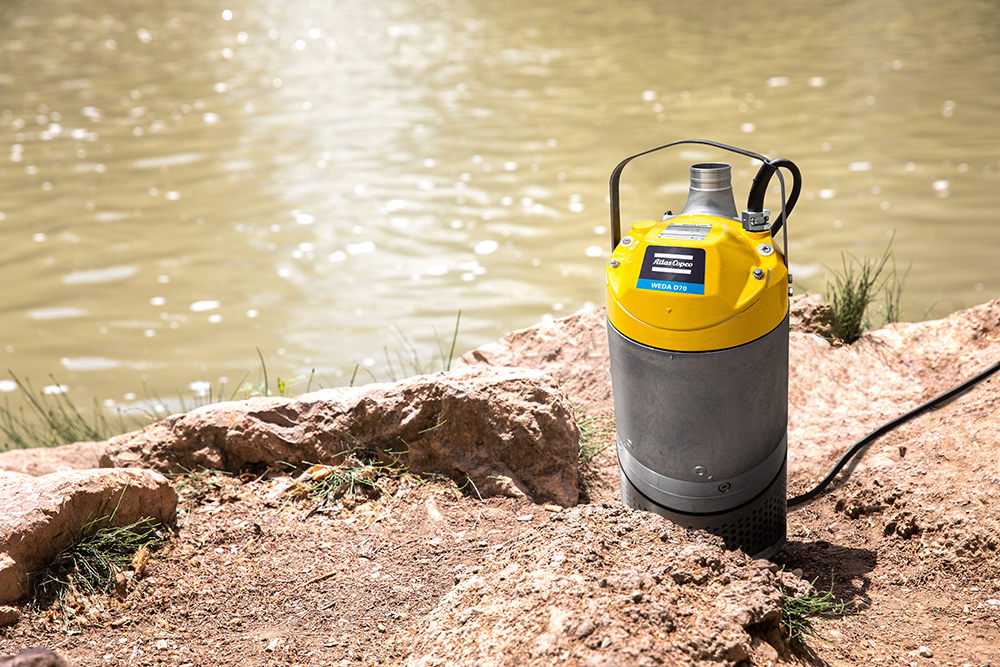
Additionally, producers will know that a change in the deposit can have significant impact on your final product, especially when it creates more waste. New feed throughput must increase just to make the same amount of product. This means, the system is no longer operating optimally, and equipment may not be performing efficiently.
Plants producing more waste can lead to filling up the tailings area faster than planned. This can lead to a halt in production or significantly modified operations so that producers can dig out ponds more frequently. Undertaking this endeavour is usually time-consuming and expensive since specialized equipment may be required.
More waste does not just mean more sand in a pond. With a depleted tailings area, water quality can suffer, and additional land permits may be required.
An UltraFINES recovery plant will, says McLanahan, pull a majority of the solids out of the waste stream, keeping them from the downstream water management system, thereby saving a pond from filling up, decreasing a load on a thickener or lowering operating time on a filter press.
At times, plants may also be faced with an overload condition or an underload condition that keeps the process system from working in its optimum range. This situation will send material in the wrong direction with good product ending up in a waste stream. With a McLanahan UltraFINES recovery plant in place to act as a safeguard, it is said to be possible to blend that material back in or batch it through the process to prevent the loss.
Adding equipment may seem like it is counter-intuitive, but unforeseen operational costs come in all shapes and eat up profitability quickly, notes McLanahan. Proactively handling the issue up front puts you in control, while reacting to the issue can drive up costs and strain resources when it becomes urgent.
However, conditions and markets change, and sometimes, plants need to be updated. When the situation arises, a combination of the points above can drive the placement of a modular unit like the UltraFINES recovery plant. When planned accordingly, a modular UltraFINES recovery solution can be a drop-in improvement to an operation’s capacity that allows it to meet the new demands.
Because the UltraFINES recovery plant is an add-on process, it can fit into most operations fairly quickly and with minimal disruption. An ultra-fines recovery unit does not demand a lot of monitoring and can be set up with remote instruments.
Ultimately, McLanahan notes that an UltraFINES recovery plant is not the answer for every problem, but when it comes to fines, it is a good place to start. When it is the right solution, McLanahan claims an UltraFINES recovery plant will pay for itself in a short time. The major US-headquartered, global quarrying plant market manufacturer has been working with these types of issues for a long time and knows how an UltraFINES recovery plant can make the difference.
Atlantic Pumps’ key focus is on ‘keeping abrasive fluids moving’, as its strap line goes. With the key pump families of Audex and SlurryPro, plus Gromatex heavy-duty rubber-lined products, the company works to provide a comprehensive, efficient pumping solution for all quarry-water-handling needs.
According to Atlantic Pumps managing director, Andy Smith, the most pressing need for quarry operators now, and probably over the next two to three years, is energy supply cost. For commercial and environmental sustainability, many quarries are urgently seeking to optimise their equipment, ahead of the rapidly increasing energy costs expected this winter.
While heavy-plant decisions are often years in the making, “pump operations are an area that can deliver substantial cost-performance improvements, fast,” notes Smith.
The daily work of Atlantic Pumps is optimising dewatering operations by reducing downtime, maintenance costs and fuel use by correct specification of newer, more energy-efficient pumps. A typical customer story is an independent quarry in the Scottish Lowlands, which recently approached Atlantic Pumps for help with a problematic dewatering pump. The operation’s diesel-powered pump was suffering repeated breakdowns, with multiple (and expensive) trips back to the manufacturer failing to sort the issue.
Technicians from Atlantic Pumps studied the site’s dewatering needs afresh and recommended a solution involving two 37Kwh 6” electric submersibles from the Audex AS range. With these suspended from a pontoon on the lagoon and being managed by a modern control panel, the optimum running efficiency and uptime made for vast operational savings.
Like many established quarries, they had traditionally relied on diesel power so the recommendation of electrically powered pumps may have surprised them somewhat, especially as the location meant mains power was out of the question. Before making the move, the buying team went through all the details in consultation with Atlantic Pumps. Consideration was given to pump wear life, maintenance routines, volume and head variation, sustainability, and lifetime cost plus, of course, return on investment.
Even despite the electrical power being supplied by a generator, this setup is said to have provided more flow capacity than the previous diesel pump – for just 60% of the previous running cost. This level of cost reduction was obviously a huge win for the quarry, aside from solving the original reliability issue that triggered their consultation with Atlantic Pumps.
A frequent phenomenon that Atlantic Pumps’ technicians come across is pumps that have been vastly over-specified (“P is for Plenty”, as the sappers used to say). Whilst this might cover the backs of someone guessing which pump size they need; it always leads to unnecessary fuel wastage for the pump’s entire lifetime. Considering that an average of 80% of a pump’s lifetime cost is in its running, this is probably one of the most important considerations when replacing a pump. So, doing some maths and reading the pump flow-curve diagrams, running your needs past a pumping consultant, or at least asking the pump supplier for advice is, in Atlantic’s opinion, a wise approach.
The other major consideration on quarry operators’ minds is water reuse and compliance with Environment Agency discharging permits. Undoubtedly, if it wasn’t for the current energy crisis, the management of water resources is the next most pressing issue. The EnviroHub system featured at Hillhead this year received a lot of orders and interest from firms involved with a variety of dewatering scenarios. EnviroHub filters, monitors, and treats turbid and out-of-gauge pH wastewater using the latest smart technology and cloud-based communication. It reports (and logs) volume, clarity and pH value data to enable site managers to demonstrate compliance with licensing requirements. It can also be integrated into other dewatering components and control pump switches or valves for extended automatic water control. Examples of its success are found on HS2 sites recycling concrete washout water, to a Gloucestershire project supporting the recovery of salmon breeding by further cleaning ‘clear’ brook water as it enters the river Frome.
One of the most difficult quarry-water types is sand-laden slurry; the heavier-than-water sand particles are both aggressive on pipe and pump linings and, with their angular facets, prone to ‘lock’ together as a near solid bed wherever they can. Such slurry is often encountered in wash-plants and quarry runoff. Atlantic Pumps is likely to recommend one of the Audex AW submersible pumps for this turbid slurry, or a surface-mounted pump from SlurryPro.
The Audex AW submersible pumps have an agitator built in to keep the sand/solids in suspension to prevent clogging and use abrasion-resistant metal alloys for the pump chamber and impellor blades. SlurryPro manufactures powerful centrifugal type pumps which, depending on the circumstances, are fitted with either rubber or high-chrome impellers to resist the abrasive nature of quarry slurries. SlurryPro also makes a sliding base which makes cleaning out and replacing impellor linings on split-case-type centrifugal pumps much easier, safer and quicker.

